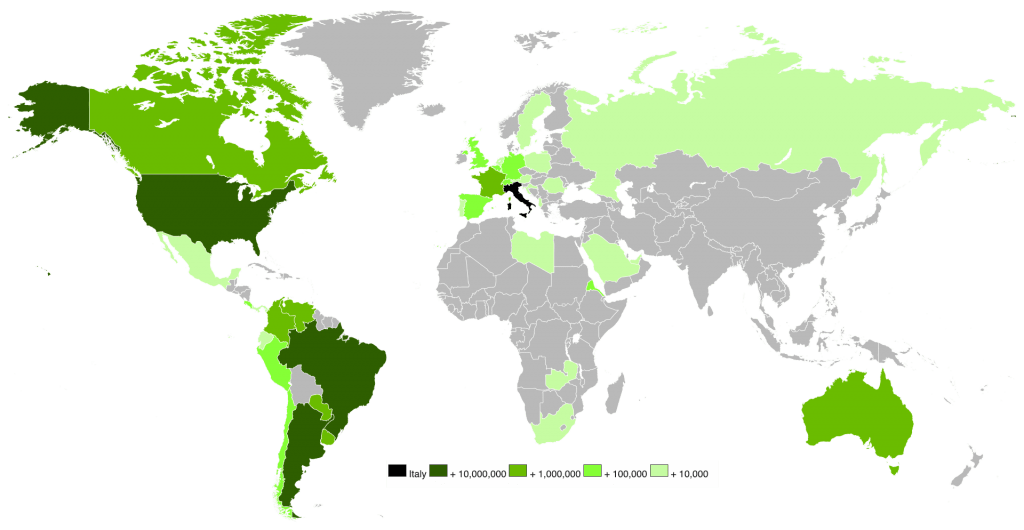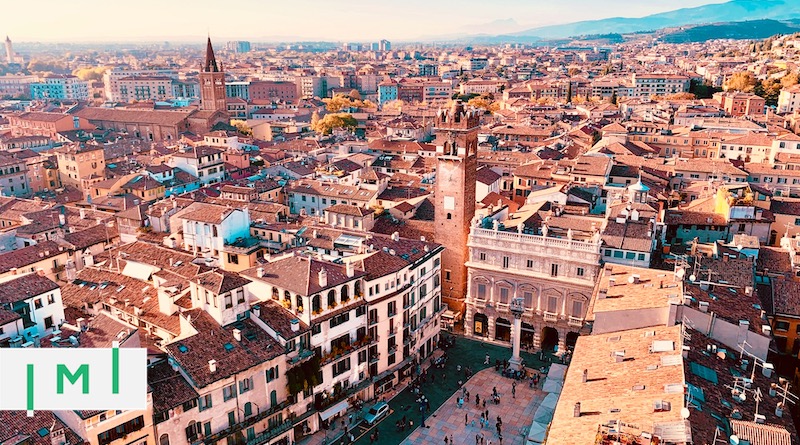Italian Citizenship by Descent: Up to 80 Million Worldwide Potentially Eligible
Italy will grant citizenship to those who can demonstrate Italian ancestry, practically no matter how far back. From Buenos Aires to Boston, tens of millions are likely eligible.
Though estimates are rough and vary considerably between sources, even a conservative count pegs the magnitude of the Italian Diaspora at some 83 million people worldwide today. The largest Italian-heritage communities outside of Europe are found in North and South America, particularly in Argentina, Brazil, and the United States.
| Country | Est. Italian descendants | Source |
|---|---|---|
| Brazil | 31,000,000 | Source |
| Argentina | 25,000,000 | Source |
| United States | 17,000,000 | Source |
| Venezuela | 2,000,000 | Source |
| Colombia | 2,000,000 | Source |
| Canada | 1,351,335 | Source |
| Uruguay | 1,055,220 | Source |
| Peru | 500,000 | Source |
| Other | 3,093,445 |

At an estimated 31 million, Brazil is home to the single-largest population of Italian descendants, followed by Argentina, where up to two-thirds of the population have at least one Italian ancestor. A further 17 million Americans self-report as being of Italian origin.

How to qualify for Italian citizenship by descent
David Lesperance of Lesperance & Associates explains the steps to qualify for Italian citizenship by descent.
“The first stage,” says Lesperance, “is to determine if someone may be entitled to Italian citizenship.”

In order to be potentially eligible, he explains, the individual must have an ancestor who:
- Was born in Italy no matter how many generations back; AND
- Was alive and not yet a citizen of another country as of March 17, 1861, the date of Italian unification; AND
- Did not naturalize in another country before July 1, 1912.
Additionally, if naturalized, the ancestor’s naturalization must also have occurred after the birth of the non-Italian born child. This continuation of Italian citizenship vests the non-Italian born child with Italian citizenship at birth automatically.
If the ancestor never naturalized, the current descendant automatically qualifies
A few quirks and exceptions
- Descendants whose line of ancestry includes women must pay attention to birthdates. Women could not generally pass on Italian citizenship to children until January 1, 1948 (with exceptions for unknown, deceased, or stateless father). Thus, if the prospective Italian citizenship-by-descent applicant has any female ancestors whose child was born before this date, the client must seek recognition in court as opposed to the consular (i.e., administrative) path. This is because Italian law has not yet codified the retroactive recognition of citizenship for children born prior to 1948 to Italian women. Since 2009, many have successfully sought relief in court and obtained recognition of citizenship via the pre-1948 maternal line.
- If the ancestor was from Veneto, he or she must have been alive and not yet a citizen of another country as of 1886, rather than 1881 as is the case for ancestors from every other region. If the ancestor was from Friuli Venezia Giulia, Veneto, or Trentino Alto Adige, there is an added stipulation: He or she must not have immigrated from Italy until July 16, 1920.
- If a non-Italian woman married an Italian man (or an Italian citizenship-qualifying man born outside Italy) before April 27, 1983, then she automatically became Italian upon marriage.
- Before September 22, 1922, an Italian woman’s citizenship status followed that of her husband’s. If her Italian husband became a non-Italian citizen prior to this date, she automatically also became a citizen of that country. The same goes for an Italian woman who married a non-Italian prior to September 22, 1922; she would also automatically become a citizen of that country. When descendants have no other paths by which to qualify and their female ancestors lost citizenship via marriage, this opens them up to file in court for recognition of citizenship as well.
- Similarly, Italian-born minor children’s citizenship status also followed that of their father. If an Italian-born child’s father became a non-Italian citizen, the child would automatically become a citizen of that country.
- Finally, if an Italian-born ancestor naturalized in another country before July 1, 1912, this would normally break the chain immediately. However, if his or her child was 21 or over at the time of the parent’s naturalization, the chain is not broken and the client may be eligible.
Once the descendant has confirmed that the Italian ancestor meets the criteria, he or she must gather the supporting documentation necessary to demonstrate the same to the satisfaction of the Italian government.
What types of documentation are considered?
There are many ways to demonstrate Italian ancestry. Types of documentation that may be taken into consideration include, but are not limited to:
- Old passports;
- Birth certificates;
- Marriage certificates;
- Genealogical evidence;
- National population registry records;
- Ship manifests;
- Ellis Island records;
- Church records;
- Etc.
Read other articles in our Citizenship-by-Descent series:
- 10 Million Polish-Americans Potentially Eligible for EU Citizenship by Descent
- Even for The Super-Rich, Citizenship by Descent is Extremely Useful: Lessons From Abramovich
- Everything You Need to Know About Latvian Citizenship by Descent
- The Complete List of EU Citizenship by Ancestry/Descent Policies
- Bulgaria Grants EU Citizenship by Descent Up to 3rd Generation: Hundreds of Thousands Qualify
- Czechia: Hidden Citizenship-by-Descent Gem? New Data Suggests So
- Slovakia to Grant Citizenship by Descent up to 3rd Generation: 800,000 Americans Could Qualify
Think you may qualify for EU citizenship by descent?
Ask a specialist
Christian Henrik Nesheim is the founder and editor of Investment Migration Insider, the #1 magazine – online or offline – for residency and citizenship by investment. He is an internationally recognized expert, speaker, documentary producer, and writer on the subject of investment migration, whose work is cited in the Economist, Bloomberg, Fortune, Forbes, Newsweek, and Business Insider. Norwegian by birth, Christian has spent the last 16 years in the United States, China, Spain, and Portugal.



